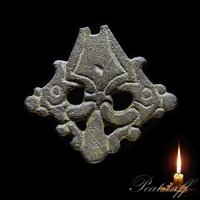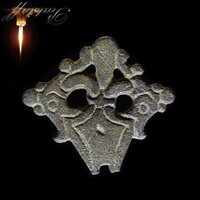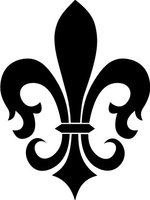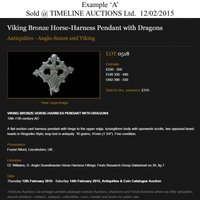An Anglo-Scandinavian horse harness pendant in Ringerike style.
This blog I like to show you an interesting horse harness pendant from England from the Viking Age.
But first a short prequel. On a regular basis I am writing about my artefacts in the magazine of the so called 'Viking Genootschap' in Belgium, the Ravenbanier. I was writing the article for the magazine for January 2017 about another horse harness pendant I have - see here - as I started to Google on 'Viking horse harness pendant'. Googling on 'Viking' and adding words to that, have costed me a lot of money the last ten years but gave me the joy of the world also..
Googling so, I stumbled on this horse harness pendant on an auction website Ebid, where I was surprised to be able to buy this one for a fixed prize. Of course I was tempted and seduced once more..
The horse harness pendant is one stylistically to be addressed as Anglo-Scandinavian in a - derived - Ringerike style. The overall execution of the pendant is 'crude but charming'. A true Scandinavian craftsman would have made a far more clever, symmetrical and well executed piece. As here, this isn't the case I would suggest that this horse harness pendant very possibly was made by or a Anglo-Saxon smith making the pendant in a deliberate Scandinavian stylish way to appeal to the taste of the Scandinavian settlers in England or was made by a successor of one of the Scandinavian settlers in England. Not being familiar in a direct way with the Scandinavian way of art, he might have attempt to imitate the Ringerike styleform.
(the candle in the photograph: I kept it this way, as everyone can use some extra light in these dark weeks to come..).
Interestingly if we turn the pendant 180 degrees upsidedown, we can distinguish also a 'fleur the lis' - clumsy executed as it might be - symbol. Now, being addressed to the 10th-11th century I like to argue even for a transverse/hybrid Anglo-Scandinavian / (Anglo-) Norman art style as by the use of this symbol. Also if one is considering one of the 'fleur the lis' variants as can be seen underneath this blog, one could easily see the horseheads as the form of the outward curlings of the fleur the lis, adding to the crude symbol on top (if turned 180 degrees) of the horse harness pendant. But - again - any remarks or alterations are welcome.
On a regular basis we can find the 'fleur the lis' symbol on horse harness pendants from the later Midde Ages. This is one of the symbols of France. A lot of English nobelty were originating from France and Normandy and encountered England via William the Conqueror. William the Conqueror encountering England in 1066 A.D., it is very well possible (also) that this horse harness pendant was made in the very late 11th century and stylistically being influenced by these Normans. But that is just a suggestion from me, wich - as always - is open for any discussion or debate.
This horse harness pendant was found in the late eighties of the 20th century by Peter Haworth approximately 1km South East of a small village called Fridaythorpe.
The area didn't produce a great deal, a few Roman items and a few later Medieval finds. But no other Saxon or Viking finds.
It wasn't recorded it with PAS as the scheme wasn't introduced until the mid 90's. Of course I will try to do yet - as I consider it as an important piece of art and such a detailled provenance is present.
Hores harness pendants were hung as ornaments on the horse harness and being used to demonstrate the social status of the rider involved. During the Middle Ages horse harness pendants were one of the objects used to demonstrate the importance or aspirations of the owner (i.e. rider). As wel as (arm)rings and brooches they were visible for individuals the owner met - or to make an impression otherwise to remember to the social standing of the owner. In the late Middle Ages, horse harness pendants are being decorated even richer by the use of enamel. Though this might have just have been pure decorational, it might as well have a so called 'heraldic' function. In that purpose it had shown that the rider was 'in service' of the person owning the horse harness pendant. The 'upper class' would have made an impressive show out of it, by accompanying their heraldic achievements, showing their horse harness pendant(s) on the great cloth covering their horse or by wearing it, embroidered on their cloths.
--> if you like to see this artefact live.. there will be an opportunity! Among many other objects, this horse harness pendant will go on display from March onwards (an exact date to be confirmed) as I am preparing (with the curator of museum Dorestad in Wijk bij Duurstede, Holland) an exhibition on Early Medieval art styles, decoration and design. This exhibition will include artefacts from the Franks, the Carolingians, the Frisians, The Balts, Finno-Ugrians, (nowadays) Rus, and.. of course.. the Viking Age (Scandinavian ietms and Anglo-Scandinavian and Hiberno-Norse items as well).
Keep a close eye on the News page in the forthcoming months!
An example of a later Middle Ages horse harness pendant with 'fleur the lis' motif you can find here:
http://www.tulliehouse.co.uk/thecollection/horse-harness-pendant-medieval
Further information:
http://www.treasuretrovescotland.co.uk/Gallery/harness_pendant.html
Clark,J. The medieval horse and its equipment c. 1150 - c. 1450 A.D.
The Finds Research Group AD700-1700 Datasheet 39 by David Williams; Anglo-Scandinavian Horse Harness Fittings, p. 6, figure 7.
When consulted FLO officers, Vanessa Oakden pointed out to me that the style of the pendant made her think about the style used in a dress hook from the late 10th, early 11 th century, wich can be seen here:
https://finds.org.uk/database/artefacts/record/id/634162
but in my opinion the dress hook is of a far more refined and detailled design and excution and can be dated somewhat earlier than the horse harness pendant here discussed.
A similar horse harness pendant was on auction at Timeline Auctions, february 2015 - see image attached of the catalogue.
Dear Tony Brady.. this one's is specifically for you - giving me a mild kick under the butt writing a blog again after some absence! It truly is people like you who give me the joy in writing and interacting on these artefacts.
So.. A high five to you.
Thomas Kamphuis, November 25th 2016.
Well. I could have been with these stones until after dark, but as my wife wanted to travel on.. well.. I see you again, some day, hogback stones from Gosforth. And if you happen to be there one day, do not forget that monument on the outside...
Further on with the Cumbrian hogbacktour !
In - yes, luckily again in - St. Peter's church in Heysham, there is a truly beautiful hogback stone. The guide told us, it had been studyied by Thor Ewing, a writer, in 2000. in 'Understanding the Heysham hogback' A tenth century sculpted stone monument and its context (link), Thor Ewing tells in detail what he dicovered on the both sides of this hogback stone.
Just being brought in the church as late as the 1970's accompanied with some protest here and there among the church visitors, considered as being a token of old paganism, it had been remarkably nice preserved, and a lot of detail can be seen, still. Truly worthwile a visit.
I had a small debate with the guide in the church if the - zoomorphic, in my opinion - faces on the sides were lions (or hippo's). The guide doubted if the vikings could have known about lions. Well I guess so, concerning the runes on the Ancient Greek lion statue at the Arsenal, Venice. For example. Vikings did travel south..
But when he told me he was doubting the vikings 'discovered' (as the native inhabitants were of course, in the first place) America before Columbus, I decided to rest my case..
One has to know when to start and to end a conversation ..
Just discovered the book in a bookstore written by Geoff Holder - The guide to the mysterious Lake District, I knew there had to be another hogback stone in Lowther, St. Micheal's Church. With a promising image described in the text of 'a naval and a land-based force of shield-bearing vikings above a fish and what might be a coiled sea serpent. On the reverse is a row of female figures with snakes, possibly a representation of the hideous hag Hel'. Wow. If that did not sound as a true pagan promised land ..
Not complaing too much after all we have seen, this visit was the dissapointing one of them all. But if you wife states 'I am happy to have seen them' and I am answering 'Measuring is knowing' and the even more obligate verb 'handling 'if we did not see it at all, we wouldn't have known anything at all of how they were looking' the glass was again half full, at the last day of our journey..
The hogback stone appeared to be just being tolerated within the entrance segment part of the church. As something you never use anymore but you do not throw away - entirely. That sort of feeling emerged when seeing this hogback asylum seekers.. Bed, bath and bread, ás we say in Dutch, but no luxury at all and standing on some outcuts of wood, you would balance the table with at home..
Come on, St. Micheal's Church.. care a bit more of your 'children' !
This hogback stone was moved in the church in 1907. Hogback stones layed partially buried in the churchyard before it was dug up and moved into the church.
The promising depiction of a longship - as certainly can be seen after some studying - see http://vikingminds.co.uk/pages/longship
we have missed !
The stone itself is (157 x 50 x 30 cm) and very worn.
The hogback stones in Cumbria - very diverse in quality, but everyone worth a visit ! Especially on a gloomy day in late October ...
The churches to visit - see photos of resp. St. Andrew's church in Penrith, St. Mary's church in Gosforth, St. Peter's church in Heysham and St. Micheal's church in Lowther.
Did I miss out on another one in Cumbria ? Let me know !
In a next blog I will take you to four - still remaining utterly mysterious- statues 'guarding' the graveyard of St. Andrew's church in Dacre..
For the last blog of October 9th see this link.
References: (as always, links to where the books can be ordered are attached).
Edwards, B.J.N. Vikings in North West England - The artifacts (1998);
Emery, Gordon, CURIOUS CUMBRIA, The Lake District & Beyond: A celebration of Cumbria (2023)
Ewing, T. 'Understanding the Heysham hogback' A tenth century sculpted stone monument and its context ;
Hall, R. Viking Age archaeology in Britain and Ireland (first printed 1990, reprinted with amendments in 1995);
Holder, G. The guide to the mysterious Lake District (2009)
possibly also (as there within the part of Cumbria dealing with Carlisle, the Eden Valley, Barrow-in-Furness, Whitehaven and the west coast is being dealed with)
Holder, G. Paranormal Cumbria (2010)
http://vikingminds.co.uk/pages/longship



